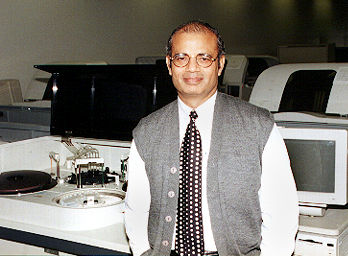December Executive Profile: Dr. Pyare Khanna
Everything Old is New Again for Dr. Pyare Khanna and Microgenics

Depending on the theory being discussed, philosophers will argue that time is either linear or circular. If you ask Pyare Khanna, Ph.D., president and CEO of Microgenics, he'll probably support the circular theory.
He's got a lot of experience in the area. Dr. Khanna first joined Microgenics in 1986 as the company's vice president of research and development. Microgenics was bought out by Boehringer-Mannheim, which was subsequently acquired by Roche.
Roche's acquisition carried a condition from the Federal Trade Commission, however. The merger would only be allowed if Roche divested itself of one of Boehringer-Mannheim's product lines the same line that Microgenics had originally created. Dr. Khanna put together a proposal with financing from Morgan Stanley Ventures, Microgenics' original investors, and the company was reborn this fall.
"We've even been able to collect the old management team that we had in the '80s," he adds. For Dr. Khanna, everything has come full circle.
Microgenic's primary business revolves around the CEDIA immunoassay technology and product line, which Dr. Khanna had a hand in creating. The products consist of genetically engineered enzymes which are modified to interact with specific substances found in bodily fluids, to determine their presence and concentration.
The company's products offer a significant improvement over the pre-existing technologies, which use natural enzymes that often vary from lot to lot. "We use recombinant technology to make an enzyme it's reproducible, you have full control over the system. To the layman, we can determine picograms of a material in the body, where other methodologies may do, probably, nanograms. We're 100 to 1,000 times more sensitive."
Currently, these assays are used primarily in measuring the presence and concentration of both "drugs of abuse" and therapeutic drugs, the latter being used by physicians to determine appropriate dosages of prescription drugs.
Dr. Khanna played a key role in the development of the techniques used to create the assays. His name can be seen prominently on a majority of the patents filed in connection with this technology.
His technical background and involvement in the company's R&D foundation givesDr. Khanna a unique perspective both on their products and on their potentials.
"When you know the details, you see, 'My God there's so much we can do,'" he notes.
Dr. Khanna saw the possibilities of the technology many years ago, but was unable to convince management to pursue his vision. It is this unrealized potential that is perhaps most exciting to him.
"The potential of the technology has never been realized completely," he says. "The focus was on only one segment of the application, the diagnostics qualitative and quantitative determination of constituents of body fluids, whether it is urine or serum or whole blood.
"We acquired the ongoing business in that area from Roche, but we are also acquiring what I think is much more valuable: the ability to pursue both diagnostic and non-diagnostic applications."
The non-diagnostic applications that offer the most potential involve the screening of libraries of compounds for new drugs by pharmaceutical companies.
"These companies have a library of combinatorial chemistry, a library of potential drugs," he explains. "Maybe somebody has five million potential compounds there, and each one is good for a particular target or disease. Our method will help them screen those compounds for a particular disease."
Dr. Khanna believes that the company's technology will offer the same strengths in this area as well.
"We offer them convenience, high sensitivity All the things which we gave to the diagnostic industry, we can offer to the non-diagnostic industry."
This area, known as pharmaceutical drug screening, will be the focus of a new company which Khanna plans to spin out of Microgenics. This, too, completes a cycle for Dr. Khanna.
"Twenty years back, I wanted to get a license for this technology to start my own separate pharmaceutical drug screening house. Now we have a chance; it's very exciting."
Also in this issue ...
- ObjectStream Translates Between Worlds
- More a Coach and Mentor than Boss
- Business Bits
- Executive Profile - Dr. Pyare Khanna, Microgenics
- Lions Ticket Office is the Source for Tickets to Community Events, More
- Changes Abound for 680 Commuters with New Bus Service and 580/680 Construction
- County Connection Offers Another Option for Commuters
- Sponsors, Participants Sought for Journey of Hope Goodwill Challenge
- Hacienda Index




